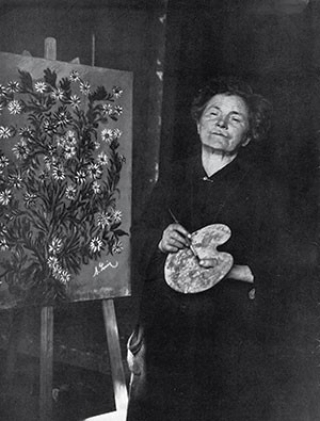Born 1864, Arsy, France
Died 1942, Clermont, France
Beginning in 1881 Séraphine Louis spent twenty years as a lay sister at a convent in northern France. She began to paint in 1903 after moving to Senlis to work as a housecleaner. She first decorated household items, then transferred her ornamental floral schemes onto small wooden or cardboard panels. In 1921 her paintings attracted the attention of one of her employers, Wilhelm Uhde, and the collector, critic, and dealer included her in his important exhibition Les peintres du Coeur Sacré (1928) alongside André Bauchant, Camille Bombois, Henri Rousseau, and Louis Vivin. Louis became known for painting tightly woven thickets of vegetation, but in 1932, after the collapse of her market, she had a mental breakdown and was admitted into a psychiatric institution. Although Louis ceased painting, her work was shown in the exhibition Les maîtres populaires de la réalité, organized by the Musée de Grenoble in 1937, which opened in Paris and traveled to Zurich and London. Alfred Barr adapted the exhibition for Masters of Popular Painting (1938) at MoMA in New York.
Inspired by her religious beliefs, Louis painted ecstatic visions of fruit, flowers, and foliage against monochromatic or horizontally divided fields of color realized in oil or Ripolin, a household enamel paint. The compositions are studded with glossy, jewel-like florae that blossom outward from roughly defined cores, such as tree trunks or vases. In later works, figure and ground merge into a dense weave, uniting the entire canvas in a pulsing, twisting rhythm. Records of Louis’s hallucinations and fixation on apocalyptic times, documented during her institutionalization, offer clues to the meaning of her paradisiacal florae and representations of the tree of life.
While most of the blooms depicted in Louis’s oeuvre are imaginative hybrids, she often painted daisies. In Marguerites she reduces the white flowers to whorls of thin brushstrokes radiating outward from glowing, spherical centers. A row of stylized leaves frames the flowers against a mysterious, dark field. Feuilles features a more specific sense of space, even as the swarming mass of leaves merges expressively into the brushwork of the yellow background. As in many of her later works, tiny daubs and dots of paint cluster decoratively across the surface, lending the painting an otherworldly radiance.
Jenevive Nykolak
Körner, Hans, and Manja Wilkens. Séraphine Louis, 1864-1942: Biographie, Werkverzeichnis-biographie, Catalogue raisonné. Berlin: Dietrich Reimer Verlag, 2009.
Uhde, Wilhelm. Five Primitive Masters. Trans. Ralph Thompson. New York: Quadrangle Press, 1949.
Wolf, Falk, and Kasper König, eds. The Shadow of the Avant-Garde: Rousseau and the Forgotten Masters. Berlin: Hatje Cantz, 2016.
